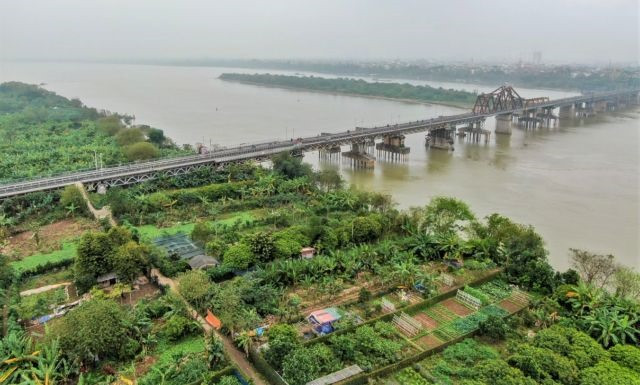
However, some people living in a number of the ancient villages along the dyke became anxious they would be relocated.
According to the Red River sub-division planning, existing residential areas that will be kept and protected include Chu Phan - Tráng Việt, Tàm Xá - Xuân Canh, Nhật Tân – Tứ Liên, Hoàng Mai, Thanh Trì 1, Thanh Trì 2, Đông Dư – Bát Tràng, Kim Lan – Văn Đức, and some areas of Tây Hồ, Hoàn Kiếm, Ba Đình and Hai Bà Trưng districts, with the exception of some areas of narrow riverbed with a high risk of flooding.
Deputy Director of the Hà Nội Institute of Planning and Construction, Đào Duy Hưng, said that all the residential areas would be renovated and reconstructed with upgraded infrastructure.
At the same time, the residential areas will be expanded by 5 per cent to build more houses for the needs of migration, population expansion and resettlement, Hưng said.
"The content of the master plan is very practical to stabilise people's lives in the area outside the dyke and to meet people's expectations for many years," Hưng said.
Nguyễn Thị Sự, a resident in Tứ Liên Ward of Tây Hồ District, told the Kinh Tế & Đô Thị (Economic and Urban Affairs) online newspaper: “My family of three generations has lived in the Tứ Liên mudflat area of Hồng River for nearly 40 years. Since 2002 and earlier, the area often suffered from river flooding, so life was hard.”
“But in the last 20 years, the water of the Red River has dried up, there have been no floods, along with the Government's investment in roads, drainage systems, and adequate clean water supply, people’s life has stabilised. Knowing that people in the Tứ Liên mudflat area will not have to move, we are very happy.”
Tạ Việt Dũng, chairman of Lĩnh Nam Ward of Hoàng Mai District, a locality with about 110ha of land in the river mudflats with 11,000 residents, said that the city's approval of the Red River urban zoning plan was a basis for the detailed 1/500 scale planning to help the local government manage the land fund and construction.
If the plan is approved, granting construction permits to people living in the mudflat areas will be considered to relieve concerns that existed for many years because permit issuance stopped in 2016, Dũng said.
When the planning is realised, it will be an opportunity for the locality to invest in building infrastructure to improve the quality of people’s lives in the area and help the management of land, construction and the environment, he added.
Worries
Along with identifying residential areas to retain, the plan mentions relocating some residential areas in the narrow riverbed area to ensure people’s safety and flood prevention work.
People in areas of Võng La – Hải Bối, Bát Tràng, Bắc Cầu, Bồ Đề, Đông Ngàn, Yên Viên, Thượng Thanh and some other areas will be displaced.
In particular, people in the Bắc Cầu residential area in Ngọc Thuỵ Ward of Long Biên District are concerned. The residential area is located on the strip of land between the Red and Đuống rivers, nearly 3km long from Ngọc Thuỵ dyke, stretching along the rivers.
According to the plan, the number of displaced households in the Băc Cầu residential area is 757. However, there are currently four residential groups with 2,300 households who have lived there for generations.
According to Đào Khắc Thóc, an 84-year-old resident in the area, Bắc Cầu is an ancient village of Phủ Từ Sơn of Bắc Ninh Province, which later merged into Gia Lâm District, now Long Biên District of Hà Nội.
In the past, the village was part of the mainland. In the reign of King Thiên Đức (544-548), the Đuống River was dug, so the village was located between the two rivers, Thóc said.
In the past, he said that the Bắc Cầu villagers had traditional occupations such as growing mulberry, weaving silkworms, and raising livestock.
In 1971, a flood wiped out everything, but the water receded, and the villagers returned to rebuild their houses and restore their lives.
“Because of the love that has been attached here for many generations, if we have to relocate, there will be households that disagree,” Thóc said.
“To create consensus with the State policy, we hope that the planning will be public and transparent so that people can understand what and how the land will be used after we move away from the land of our ancestors. There must be a reasonable compensation and a resettlement policy for people to ensure their lives as Bắc Cầu people are currently mainly trading and doing business."
Nguyễn Kim Ý, a Party secretary of the resident group, said since 2007, the city had invested in embanking the area so village land no longer eroded.
For more than two decades, the Red River has not had a flood, and residential areas have invested in building roads and other infrastructure work, so life is very stable, said Ý.
Although there has been no official announcement from the local government, people know of the displacement and are very worried.
According to Đào Ngọc Nghiêm, president of the Việt Nam Urban Planning and Development Association, the Bắc Cầu residential area was formed due to the fluctuations of floods and not on illegally encroached land.
Previously, there was a policy to encourage people to move to this area after the city focused on construction development, Nghiêm said.
To create a consensus on relocation, the municipal authority should investigate and collect people's opinions to set an appropriate resettlement policy for those displaced.
According to the plan, the areas of mudflat land that are allowed to be built and expanded to serve relocation need to focus on investment to make a better quality of life and stay in accordance with the lifestyle of the local people, he added.
Source: VNS